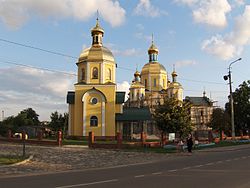Berezne
Berezne
Березне | ||
|---|---|---|
 Orthodox church in Berezne | ||
|
Magdeburg law 1584 | | |
| Population (2022) | ||
| • Total | 13,126 | |
Berezne (
Overview
Berezne (historically known also as Bereźno as well as
Interwar period
In the Second Polish Republic during the interwar period, Bereźne bore the distinction of being one of the two cities in Poland with the most Jewish inhabitants in the country. Some 94.6 percent of Bereźne overall population of 2,494 inhabitants (or 2,360 persons), were Jewish. The second largest Jewish presence in Poland, amounting to 94.4 percent of the town's population, was in Luboml.[5]


World War II
Bereźne was overrun by the Soviets in 1939. In 1941 the German
In 1943, during the Volhynian Genocide, 96 ethnic Poles of Berezne were murdered by Ukrainian nationalists of the Ukrainian Insurgent Army. The first attack on the town took place in June 1943. Other attacks occurred in the second half of that year, and as a result Polish survivors fled to larger towns, such as Rowne. In June 1945 the remaining Poles were forced to leave Berezne in accordance with the Allied treaties.
After the breakup of the Soviet Union, culminating with Ukrainian independence, Berézne became the administrative centre of the Berezne Raion of western Ukraine.
The Holocaust survivors
Only a few hundred of the Jews of Berezne survived the Holocaust. Most of them escaped from the forest camp to the village of Mazorisz (Mazorish) where the Polish villagers that gave them food and shelter in return for firewood used for heating. Some left the area together with the Communists, before the Nazis entered. For many years there stood a monument memorializing the over 3,000 men, women, and children who were slaughtered by the Nazis and local Ukrainian collaborators, at the site of their mass grave. Corresponding to common Soviet practice, the Soviet authorities refused to mention on the monument that the 3,680 murdered victims were Jews, instead describing them as "citizens of the Soviet Union".[6]
References
- ^ Чисельність наявного населення України на 1 січня 2022 [Number of Present Population of Ukraine, as of January 1, 2022] (PDF) (in Ukrainian and English). Kyiv: State Statistics Service of Ukraine. Archived (PDF) from the original on 4 July 2022.
- Gubernia, after administrative changes in the Polish Second Republic in 1922, was assigned to Powiat Kostopol as seat of the Kostopol County. Archived from the originalon 2018-01-29 – via Internet Archive, 2018-01-29.
- ^ "Історія міста Березне" [History of Berezne]. www.berezne.org (in Ukrainian). 2008. Archived from the original on 2009-04-07. Retrieved 2021-05-27 – via Internet Archive, 2009-04-07.
- (PDF). Polish National Census of 1931 for the Volynian Voivodeship. Page 56 / 361 in current document (or 26 in print) – via Wikimedia Commons.
- ISSN 1643-2312. Archived from the original (PDF) on 2009-11-22 – via Internet Archive.(94,4%) liczący 3328 mieszkańców, w tym 3141 Żydów, i Bereźne (94,6%) z 2494 mieszkańcami, w tym 2360 wyznania mojżeszowego.
Najwyższy udział ludności wyznania mojżeszowego charakteryzował dwa miasta na Wołyniu: Luboml
- ^ a b Virtual Shtetl. "History of the Jewish community of Bereźne" [Historia. Społeczność żydowska]. Muzeum Historii Żydów Polskich. Archived from the original on 2012-12-21 – via Archive.is 2012-12-21.
Further reading
- Weiner, Miriam; Ukrainian State Archives (in cooperation with); Moldovan National Archives (in cooperation with) (1999). "Chapter 11: Town Clips: Berezno". Jewish Roots in Ukraine and Moldova: Pages from the Past and Archival Inventories (PDF). Secaucus, NJ: Miriam Weiner Routes to Roots Foundation. p. 404. OCLC 607423469.
